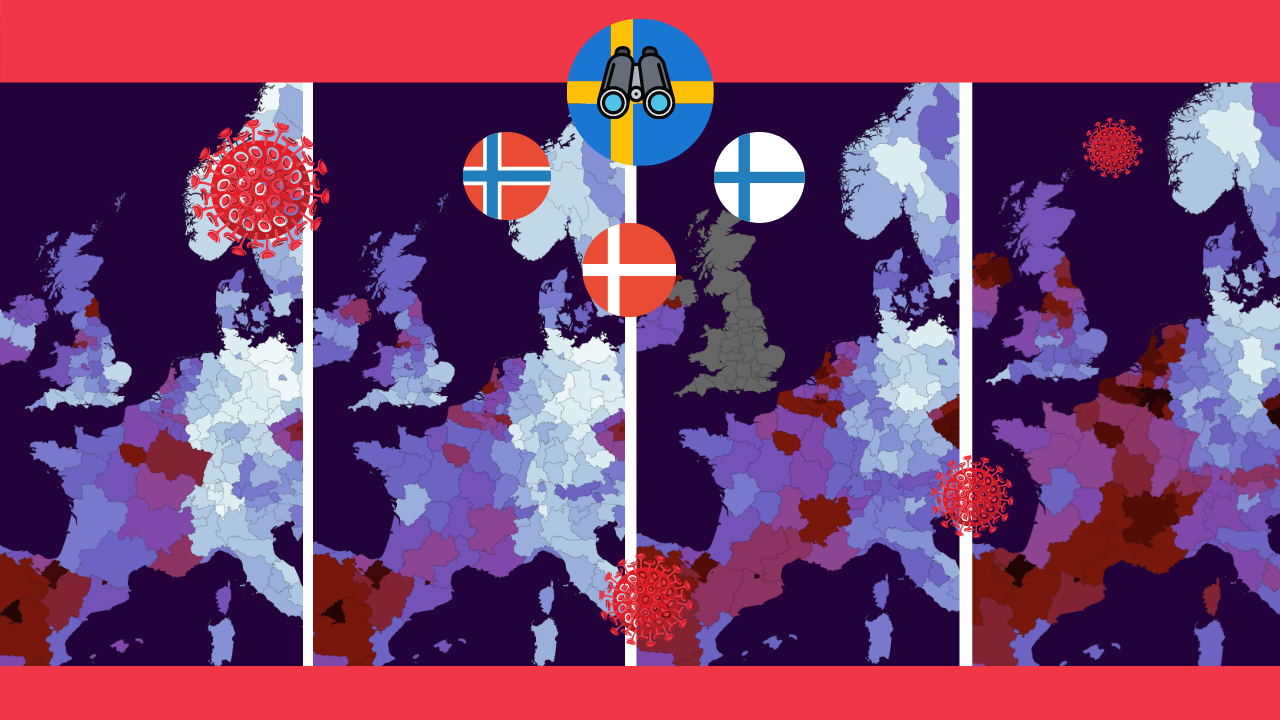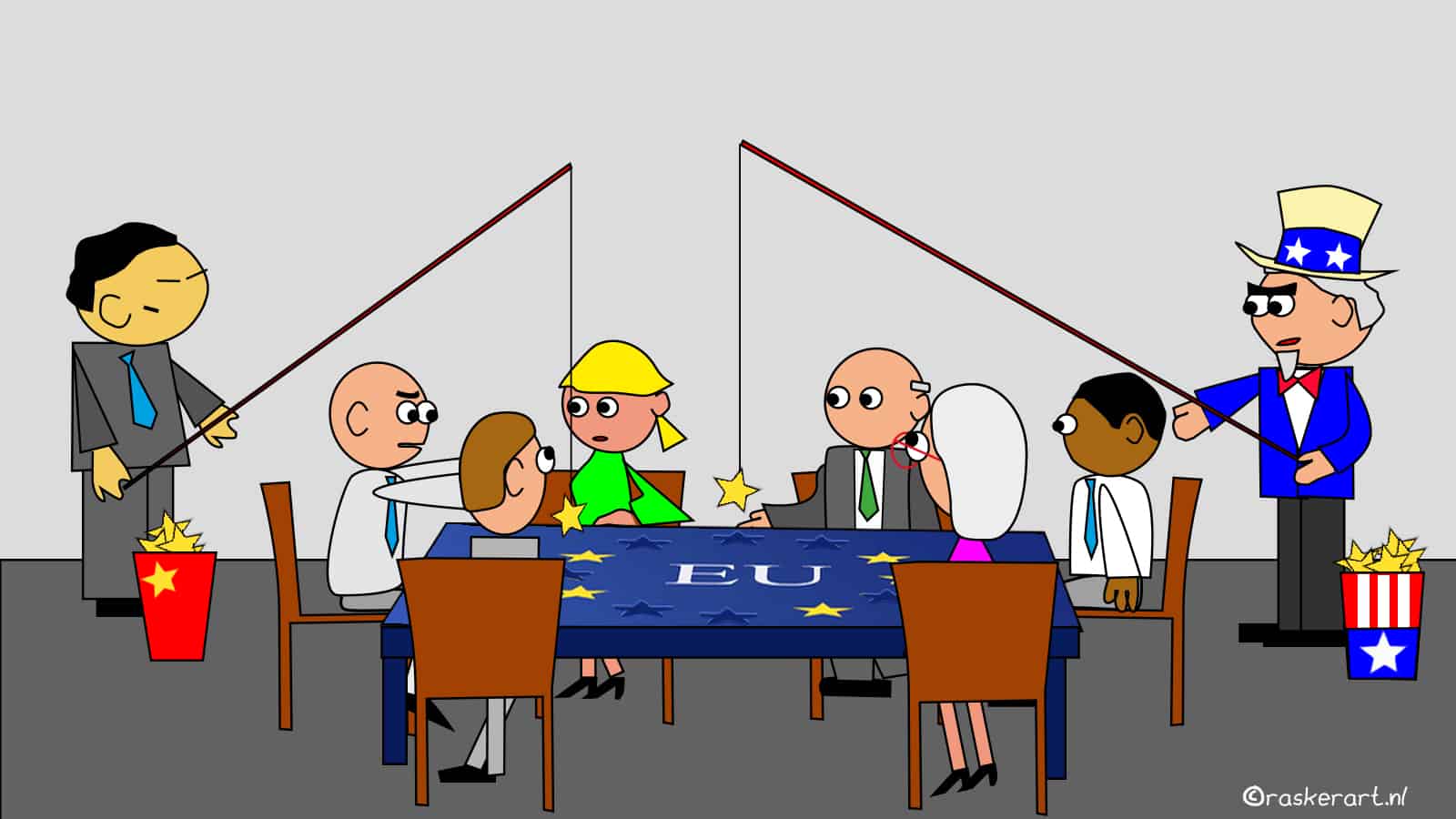
The autumn wave has erupted at breakneck speed across almost all of Europe. In a few other countries, no record increases were reported last week. Yet the corona strategy is being subjected to an unprecedented stress test everywhere these weeks.
Defense lines that have been drawn up to ensure that the situation remains as manageable as possible were central in the last installment. This week, we will zoom in on Scandinavia; one of the few regions in Europe where the figures still seem to be not too bad.
That this is absolutely not the case for the rest of the continent is made clear by the sliders below with the weekly map from October 11 to 17, along with last week’s one and that of four weeks ago. For the full picture, the third map shows the proportion of positive tests. After all, more tests invariably mean more diagnoses.
From red to black
The numbers have increased so much that yet another color has been added to the map. This indicates the difference between an increase of 400 to 500 and more than 500. Belgium – where a distinct language border is visible – as well as the Czech Republic are the worst off in terms of the number of new infections. They are followed by the Netherlands, France, the United Kingdom, and Spain. It’s all hands on deck right now in the British Isles and in Central Europe too.
The most notable measure this week came from Slovakia which wants to submit their entire population of 5.5 million to rapid testing. A similar step was taken in the spring in Iceland. Where just 364,000 people live, making it a somewhat less elaborate chore there.
Plenty of testing is also being carried out in Denmark, one of the few countries where the number of new diagnoses has been fairly stable for a number of weeks. This extensive testing is instantly visible on the Our World in Data map. Only 1.2% of nasal swabs show a positive result. This makes them, together with Germany, Norway, Finland, Greece, Serbia, and the Baltic States, the only countries that are currently under the 3% ECDC threshold. If this R value is overshot, then this may suggest that there is a lack of sufficient testing. In that case, there is a danger that the coronavirus will spread under the radar, as it did last spring. Something almost the whole of Europe should be concerned about right now.
The following graphics show the number of tests and the strictness levels of the corona regulations per country.
Scandinavian strategies
The Scandinavian countries all rely on a strong ‘we’ sentiment among the population and prefer recommendations to stringent rules. Truly drastic lockdowns with soldiers on the streets, like in Southern Europe, have never happened here. The countries all have a generous public welfare system and a population that has a lot of faith in its government. Scandinavians seem to be having far fewer problems complying with the basic rules than the more individualistic Dutch. There are also many ‘urgent’ advisories in the Netherlands, but they tend to be followed far less conscientiously.
Norway currently has the least restrictions throughout all of Europe with a stringency score of 17.5. Moreover, it is testing significantly less than other countries are. Its positive ratio is well below 3 percent, and at the same time, its rate of spread is among the lowest in Europe. What does this mean? The coronavirus is apparently not (yet) ‘prevalent’ among the Norwegians this autumn because it hardly spread there during the summer months.
This has not panned out in Denmark, where infections rose sharply in September and the reins were subsequently tightened. Based on these data it seems to be working. The increases have flattened out, one of the few countries to do so on the continent. The numerous tests (plus contact tracing) are bearing fruit and keeping the autumn wave in check. Finland also seems to have things pretty much under control, just like it did in spring.
No herd immunity
Although the situation in Scandinavia seems less critical compared to the rest of Europe at present, cocky Sweden has not got a reason to sit back and relax at the moment. The herd immunity side-effect is far from becoming a reality. The number of infections is rising faster there than in its neighboring countries. Sweden is the sole country in Northern Europe above the ECDC standard. With a decline of 8.6% in the second quarter, the country suffered a greater economic blow than Denmark (6.5%), Norway (5.2%), and Finland (3.2%). The Financial Times went into this in more detail.
So far, only 1,309 corona patients in these three countries have succumbed to the virus. The number of victims in Sweden stands at 5,918, making them the country with the twelfth highest mortality rate due to corona in the world. Respectively five times, nine times, and eleven times higher than Denmark, Finland, and Norway.
The following graphics compare the number of infections, economic downturn and mortality rates.
Economy, public health and freedom vs COVID-19
Sweden has proven to be the big loser on almost all fronts on the Scandinavian playing field. With the highest mortality rates, the severest economic downturn, the highest proportion of positive tests, and the fastest accelerating autumn wave. Furthermore, Finland and Norway are currently more flexible when it comes to measures and are on par with the stable Danes who are testing four times as much. Sweden only got two months (March and April) without a restricted lockdown in return for their lax strategy. This led to a huge fatality toll and infection rates that only dropped down to safe levels in August. This had already happened in June in other parts of Europe. Critics describe the strategy of ‘epidemiologist/’rockstar’ Anders Tegnell as an unethical social-Darwinian experiment that claimed thousands of unnecessary casualties.
Is Sweden really doing so badly on a European level? Could be worse, but in the main, it’s thoroughly unimpressive. The disaster was worse in, among others, Spain, Belgium, and Great Britain, and is nothing like that of what is happening in the Czech Republic and the Netherlands these days. So, why is there so much focus on Sweden?
This is because for more than six months the country had been systematically presented as a success story on how to weather the corona storm economically and epidemiologically ‘without’ corona measures, which would mean lockdowns would be unnecessary. Something that politicians, economists, and opinion-makers with a fondness for, or business interest in, open economies are particularly keen to hear. They are lauding fairy stories about Sweden that demonstrably do not add up.
Consistent measures
However, in actual practice, there is nothing remarkable about it. Until October 8, it was forbidden to hold meetings with more than fifty visitors, nursing homes and people over 70 are all in some sort of self-isolation. Plus, a set of basic rules is used that – apart from a recommendation or obligation to wear face masks – do not stand out. The policy has actually been more or less the same since March, so the clarity and consistency of it can be commended. But is it enough to keep out the next wave? Evidently, the Swedish government does not think so.
After all the accolades and criticism from home and abroad, the Swedish experiment is over and done with. They are now going to ‘do it differently’. Without further ado, the viral lines of defense are being stepped up following the example of other countries, and by the end of September, the ‘country that didn’t need a lockdown’ added the local lockdown instrument to their ‘toolbox’ so as not to suffer another disastrous season. An extension of these rules has not been ruled out either.
The Swedish government hereby shows that grave mistakes have been made and after this change in policy, is not actually doing anything ‘ different’ from what other countries are also doing. And if they decide to adopt the German policy, they will have to work hard to bring their testing capacity and contact tracing up to scratch.

From progressive insight to success?
For success stories in terms of the pandemic, economic and freedom-restricting misfortunes, look to Norway, Finland, Denmark, Germany, Uruguay, Australia, Japan, South Korea, Taiwan, Iceland, Vietnam en New Zealand. They all differ greatly from each other, but all of them have a pro-active corona strategy. They would rather intervene too early than too late, which eliminates the need for long-lasting, all-encompassing lockdowns. This ensures the shortest periods of restrictions on freedom, the least amount of psychological and physical distress for society, the lightest blow to the economy, and the greatest electoral success. Everyone is happy.
In contrast, doubting dawdlers without a clear vision have been hit hardest by the pandemic. Is the Netherlands in any better shape than Sweden at the moment? No. The figures in our country are much more alarming. In the north, the population is also more inclined to say ‘yes’ there rather than ‘yes, but …‘ whenever the government issues an urgent advisory.
Moreover, Sweden can avoid a continental catastrophe if it now adopts a pro-active approach, learns from its neighbors and responds quickly. And this might make all the difference..
Except that nothing is left anymore of that early Scandinavian spring fairy tale that initially sold so well.
Previous Corona in Europe columns.
12 October: How 5 viral lines of defense prevent a lockdown
05 October: What went wrong in the Czech Republic and Israel?
28 September: How the Netherlands got entangled in a chaotic communication web
22 September: Where are the strictest and most lenient corona measures in force?
14 September: How to interpret the autumn peak of the pandemic
31 August: Spain versus Finland







